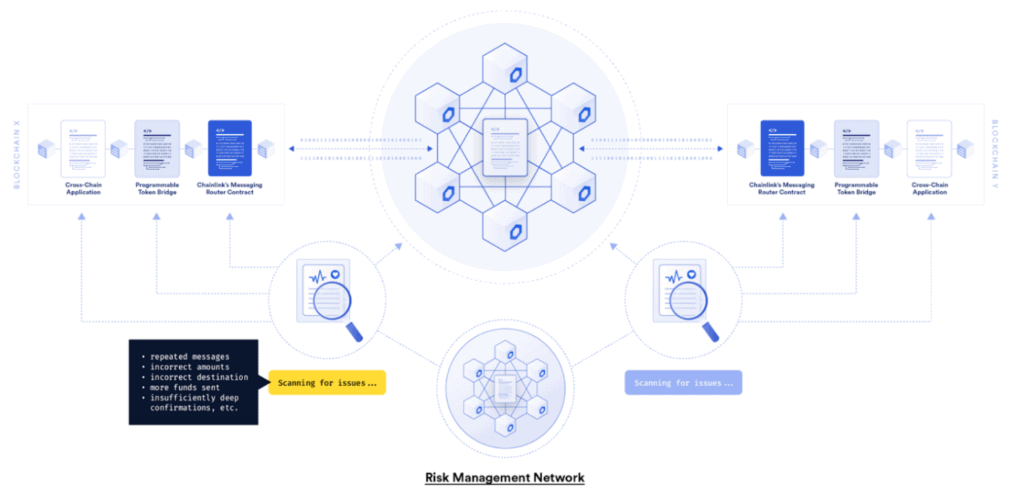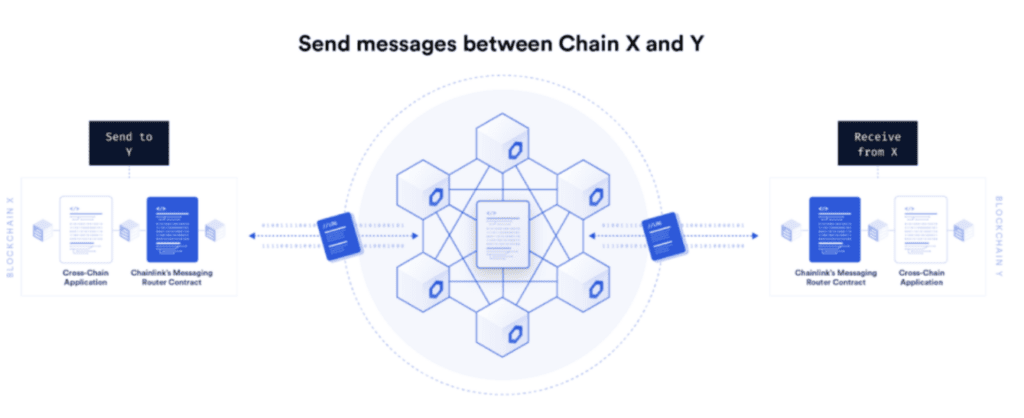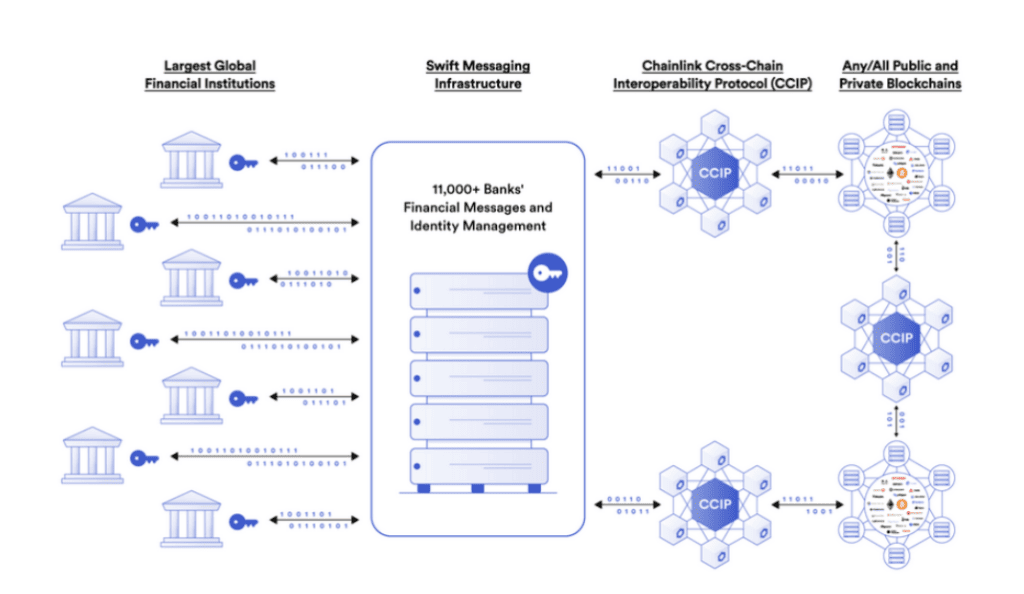Founded in 2014, Chainlink is an oracle provider connecting smart contracts to external data, using node operators to verify all data. These node operators must stake their LINK, Chainlink’s native token, to do so, earning rewards for correct information.
Addressing the Challenge of Blockchain Interoperability:
The primary goal of cross-chain technologies is to facilitate the exchange of information across different blockchains. Prominently, cross-chain bridges have emerged as a significant cross-chain technology, enabling the migration of cryptocurrencies, NFTs, and other data between blockchains.
Cross-chain bridges do offer a way to move tokens between blockchains, but they fail to fully resolve the interoperability challenge. Moreover, they pose security and user experience concerns. Reportedly, over $2 billion has been lost due to cross-chain bridge vulnerabilities in the first three quarters of 2022. These bridging technologies are intricate and often susceptible to exploitation.
Apart from security concerns, cross-chain bridges are still in their infancy and primarily cater to asset bridging. However, this falls short of achieving true “communication” between blockchains, which entails utilising the capabilities of other chains beyond just information exchange.
CCIP
Currently, Chainlink’s oracle protocol is employed to provide price feeds on DeFi platforms across various smart contract blockchains. Hundreds of DeFi platforms, with a cumulative value locked exceeding $20 billion, rely on Chainlink’s Oracle network for security. The Chainlink Cross-Chain Interoperability Protocol (CCIP) takes this secure consensus mechanism and employs it to establish genuine communication between blockchains.
CCIP was released on the 17th of July 2023. Its communication goes beyond mere asset exchange; it engenders actual communication between blockchains. This means that blockchains can leverage each other’s capabilities, encompassing security infrastructure, scalability measures, and transaction processing capabilities.
The security model underpinning price oracles, designed to resist flash-loan attacks and other threats, forms the backbone of CCIP’s protocol.
Sergey Nazarov, Chainlink’s co-founder, likened CCIP’s ambition to become the “TCP/IP of finance” to the fundamental architecture that underlies the internet. The network has initiated collaborations with major players in traditional finance, including Swift, BNY Mellon, Australia and New Zealand Banking Group (ANZ), BNP Paribas, Citi, Clearstream, Euroclear, Lloyds Banking Group, SIX Digital Exchange (SDX), and The Depository Trust and Clearing Corporation (DTCC).
This collaboration extends to both messages and token transfers across public and private chains.
Features:
- Multi-layered Security:
Fueled by Chainlink’s widely recognized oracle networks, CCIP incorporates extra security layers through the Risk Management Network and limitations on transfer rates.
A distinctive Active Risk Management (ARM) network has the purpose of identifying any potentially malicious cross-chain activities. When such activity is detected, ARM automatically halts services and safeguards user funds, akin to how banks shield customers from fraudulent transactions, as elucidated by Nazarov.
CCIP’s security is based on its Active Risk Management (ARM) Network. Within it are different ARM nodes that regularly monitor the Merkle roots of messages from the initial chain. Each node will have to either ‘bless’ or ‘curse’ the root. If the amount of ‘blessings’ reaches a certain threshold then the root can be executed. If the amount of ‘curses’ reaches a certain threshold, then the CCIP system is deemed ‘cursed’. CCIP will be paused on that chain until the contract owner can assess the safety of the situation.

Figure 1: CCIP Risk Management Network, Source: Chainlink
- Streamlined Token Transfers:
Improved token flexibility by swiftly transferring tokens across chains, achieving this faster than creating a bespoke solution.
- Dependable Transaction Execution:
A transaction cost is determined on the source chain via a gas-locked fee payment mechanism, ensuring execution certainty despite spikes in gas fees and network congestion on the destination chain.
- Scalable Design:
Eliminates the need for custom coding for chain-specific integrations by developers. Users can interact with any blockchain using a single interface.
- Adaptable:
CCIP’s evolution will persist to include new blockchains, enriched functionalities, and additional layers of security, ensuring its relevance and effectiveness over time.
- Supported Networks:
Avalanche, Ethereum, Optimism, and Polygon (MATIC).
How does it work? CCIP’s Core Functionality:
- Transfers: Send tokens to an EOA (Externally Owned Account) or SC (Smart Contract) on another blockchain.
- Messaging: Send byte data to smart contracts on different blockchains. Data may be customised instructions for a smart contract to execute, such as NFT minting.
- Programmable Transfers: Send tokens and byte data within a single transaction to a smart contract.
Nazarov explained, “One oracle network acts as the conduit for transmitting messages and value. The other network oversees and assesses whether the transactions passing through the first network pose any risks or not.”
For developers interested in constructing cross-chain solutions, the avenue to do so lies in building on top of CCIP via Arbitrary Messaging. Essentially, this involves a smart contract on Chain X employing Chainlink’s messaging router to dispatch messages to Chainlink’s decentralised oracle networks (DONs). These DONs then securely and confidentially communicate with the messaging router of the target chain, which validates the data and forwards it to the smart contract on Chain Y.

Figure 2: CCIP Messaging, Source: Chainlink
When a message is sent, the Messaging Router on the source chain utilises Chainlink’s DON to relay messages to the destination chain. The message is then validated by the Messaging Router on the destination chain, translated if necessary, and delivered to the destination chain’s smart contract. The source chain confirms the executed transaction.
Developers working on decentralised applications can utilise Chainlink’s CCIP to integrate features from different blockchains into a single smart contract. The concept revolves around constructing a smart contract that essentially acts as multiple contracts on diverse chains, interacting cohesively. This approach empowers developers to create applications that harness the speed of one blockchain while benefiting from the security of another and the scalability of additional chains.
Applications employing CCIP will foster unity between blockchains, facilitating seamless interaction through a single smart contract code. Developers can cherry-pick features from various blockchains, leveraging Ethereum’s security, Polygon’s speed and scalability, and decentralized oracle networks to provide data services.
Leading DeFi Integrations
- Synthetix: Synthetix functions as a DeFi protocol, serving as a liquidity layer supporting an array of on-chain derivatives and financial instruments. Among its recent advancements, the Synth Teleporter stands out, offering users a streamlined route for transferring Synth liquidity across different chains. This mechanism involves burning sUSD (Synthetix’s stablecoin) on the source chain and subsequently minting an equivalent sum of sUSD on the target chain.
The Synth Teleporter leverages Chainlink’s CCIP to perform secure and precise token burning and minting across chains, ensuring both reliability and safety. This unique burn-and-mint model enhances capital efficiency, eliminating the necessity for liquidity pools. As a result, Synth Teleporters allow Synthetix liquidity to flow to regions with high demand, sidestepping limitations posed by traditional token bridges.
- Aave: A lending protocol enabling on-chain borrowing and lending, is integrating Chainlink CCIP into its protocol via BGD Labs, a Web3 development initiative. This strategic move aims to future-proof the cross-chain governance system of the Aave Protocol. The continued integration of more chains into CCIP positions AAVE to conveniently expand its presence across diverse chains and execute pivotal activities like governance through a fortified solution.
Competitive Landscape
Chainlink’s CCIP is certainly not the first cross-chain bridge on the market. Its competitors include LayerZero, Multichain (recently compromised), and Celer Network’s Bridge.
- LayerZero is a cross-chain bridge that allows users to transfer assets and developers to transfer messages between blockchains, using what it refers to as ‘Ultra-Light nodes’. In this case, it deploys a decentralised oracle to retrieve block headers rather than storing them sequentially. As of 2022, it has integrated Chainlink’s data oracle.
- Multichain allowed users to bridge tokens and messages between blockchains, using its Secure Multi-Party Computation (SMPC) network. Independent nodes signed transactions, and its multi-signatory system will only allow transactions that reach a certain threshold to go through. It was recently hacked, but this has been deemed to have most likely been due to the project administration’s key being compromised.
- cBridge is a cross-chain bridge built by Celer Network, allowing the transfer of assets between blockchains as well as the development of interchain dApps. Its State Guardian Network (SGN) deploys nodes halfway through the transaction, as well as after the transaction to monitor the process. These nodes can put up “SGN bonds”, which are slashed if they do not fulfil the Service Level Agreement (SLA) terms for the transaction.
Value Accrual
CCIP fees include both gas and a premium;
- Destination gas cost: Average cost on the destination chain to process a message and/or transfer of tokens.
- Network premium for messages: Flat fee paid by users when sending messages cross-chain.
- Premium for tokens: Percentage fee paid for cross-chain token transfers.
Fees for CCIP can be paid with a variety of assets. However, if one wishes to use an asset alternative to LINK, there will be a surcharge of 10%. Moreover, these assets will be auto-converted into LINK at a later stage, but are done so manually at the moment by replacing them with LINK in the CCIP contracts. LINK is then paid to service providers, such as node operators.
While the surcharge may encourage users to purchase and use LINK instead, users who do not already own LINK may find the prospective LINK gas fee high enough at times that they opt to pay with an alternative asset.
It should be noted that even though the assets will be auto-converted into LINK, this may not significantly impact the price of LINK in the short term as Chainlink plans to release 7% of non-circulating supply into the market over the coming quarters. This was primarily led to support users & node operators from dramatically elevated LINK volatility & prices as new changes to the staking mechanics are set to introduce an 80% increase in its pool cap that will account for 8% of circulating supply.
Moreover, if the price of LINK were to increase, and thereby increase gas costs, CCIP users would be expected to drive an increase in buy-side pressure. However, should it continue to increase, it can be expected that ARM node operators receiving LINK incentives will bring about supply pressure as they realise their service fees into other assets.
Token Summary

Figure 3: Chainlink Stats, Source: Greythorn Research Team, Data: CoinGecko
Tokenomics (Initial)

Figure 4: LINK Tokenomics (Initial), Source: Greythorn Research Team, Data: CoinGecko
Bullish Fundamentals
- Broad scope of use cases:
- Interchain Lending
- Cost-Efficient Transaction Processing: The Chainlink CCIP can serve as a solution to lessen the computational burden of processing transaction data on certain chains
- Optimal Feature Selection: Leveraging Chainlink CCIP, users gain the ability to capitalize on the network effects inherent to specific chains, all while harnessing the computational power and storage capabilities offered by other distinct chains.
- Security-centric
- Leading DeFi Partnerships:
Partnered with decentralised applications Synthetix and Aave. Synthetix will use the bridge to allow users to transfer liquidity between chains. For Aave, it will provide a cheaper and more streamlined alternative to its current cross-chain governance, which uses several chain-native bridges.
- Tapping into TradFi using Swift:
Chainlink’s interoperability solution leverages Swift’s widely utilised messaging infrastructure, a system embraced by more than 11,000 global banks to facilitate international payments and settlements. In 2021 alone, this network effectively settled an impressive $1.8 quadrillion in transactions.
“Similar to how pivotal standards like TCP/IP transformed the fragmented early internet into the unified global internet we all use today, CCIP aims to unite the fragmented public blockchain landscape and the burgeoning bank chain ecosystem into a cohesive Internet of Contracts.”

Figure 5: How Chainlink uses Swift to connect TradFi & Web3, Source: Chainlink
Bearish Fundamentals
- Risk Management: CCIP’s success heavily relies on maintaining the integrity of data and transactions transferred between blockchains. Ensuring that malicious activities are detected and prevented across various interconnected chains will be crucial to its adoption.
While Chainlink’s Anti-Fraud network aims to detect and prevent malicious transactions, the challenge lies in continuously evolving and staying ahead of new attack vectors. The effectiveness of this network in identifying and mitigating emerging threats will influence CCIP’s overall security.
- Interoperability Variability: Different blockchains come with their unique features, consensus mechanisms, and governance models. Achieving seamless interoperability between chains with varying characteristics may prove challenging and require ongoing development efforts.
Closing Remarks
In summary, Chainlink’s Cross-Chain Interoperability Protocol (CCIP) addresses blockchain interoperability challenges by enabling true communication between blockchains. Released in July 2023, CCIP goes beyond asset exchange, allowing blockchains to leverage each other’s capabilities, including security and scalability. CCIP’s security model, supported by Chainlink’s oracle networks, ensures reliability. It competes with other cross-chain bridges and integrates with DeFi platforms like Synthetix and Aave.
While offering bullish fundamentals such as broad use cases and strong partnerships, CCIP faces challenges in maintaining security and achieving interoperability between diverse blockchains.
Success depends on overcoming these challenges, adapting to changes, and fulfilling its promise of creating a unified Internet of Contracts.
References
- Binance Academy. (2022, April 11). What Is Multichain (MULTI)? Binance Academy. Retrieved August 1, 2023, from https://academy.binance.com/en/articles/what-is-multichain-multi
- BingX Official. (2023, May 16). All You Need to Know About LayerZero – Stargate, Ultra Light nodes and Huge Funding Round Success. BingX Blog. Retrieved August 1, 2023, from https://blog.bingx.com/bingx-research/all-you-need-to-know-about-layerzero-stargate-ultra-light-nodes-and-huge-funding-round-success/
- Celer. (2022). cBridge Security – Celer cBridge. Celer cBridge. Retrieved August 1, 2023, from https://cbridge-docs.celer.network/introduction/cbridge-security
- Celer. (2022). The SGN as a cBridge node gateway and Service Level Agreement (SLA) arbitrator. Celer cBridge. Retrieved August 1, 2023, from https://cbridge-docs.celer.network/introduction/sgn-and-cbridge/the-sgn-as-a-cbridge-node-gateway-and-service-level-agreement-sla-arbitrator
- Celer. (2022, March 29). Celer cBridge Partners with Conflux to Enable Cross-Chain Asset Transfers for Conflux eSpace. Celer Network. Retrieved August 1, 2023, from https://blog.celer.network/2022/03/29/celer-cbridge-partners-with-conflux-to-enable-cross-chain-asset-transfers-for-conflux-espace/
- Chainlink. (n.d.). CCIP Concepts. Chainlink Documentation. Retrieved July 31, 2023, from https://docs.chain.link/ccip/concepts#active-risk-management-arm-network
- Chainlink. (2023, July 17). Chainlink CCIP Launches on Mainnet With DeFi Leaders Synthetix and Aave as Early Adopters. PR Newswire. Retrieved August 8, 2023, from https://www.prnewswire.com/news-releases/chainlink-ccip-launches-on-mainnet-with-defi-leaders-synthetix-and-aave-as-early-adopters-301878092.html
- Chainlink (cryptocurrency). (n.d.). Wiki Golden. Retrieved August 14, 2023, from https://golden.com/wiki/Chainlink_(cryptocurrency)-BWK8E8D
- Chainlink Official. (n.d.). Discord. Retrieved August 7, 2023, from https://discord.com/invite/chainlink
- coinedition.com. (2023, June 17). Chainlink Revises Token Release Schedule For Self-Sustainability. Crypto News. Retrieved August 14, 2023, from https://cryptonews.net/news/altcoins/21170668/
- CoinGecko. (n.d.). Chainlink USD Historical Data. CoinGecko. Retrieved August 14, 2023, from https://www.coingecko.com/en/coins/chainlink/historical_data#panel
- Crypto, DeFi & NFT Analytics. (n.d.). Nansen Pro. Retrieved August 14, 2023, from https://pro.nansen.ai/token-god-mode/notable?token_address=0x514910771af9ca656af840dff83e8264ecf986ca
- DappRadar. (n.d.). Multichain – DeFi Overview, TVL Analysis. DappRadar. Retrieved August 1, 2023, from https://dappradar.com/dapp/multichain
- Di Salvo, M. (2023, July 11). Another $103M Disappears From Multichain in Potential ‘Rug Pull’. Decrypt. Retrieved August 1, 2023, from https://decrypt.co/148133/multichain-anyswap-rug-pull-hack-103-million-chainalysis
- Empire. (2023, July 21). Chainlink CCIP Bomb, UniswapX, & Synthetix upgrades explained | Roundup. YouTube. Retrieved July 31, 2023, from https://www.youtube.com/watch?v=TRPZb3aHbRc
- @ericwallach. (n.d.). Chainlink CCIP Revenue Popular. Dune dashboards. Retrieved August 2, 2023, from https://dune.com/ericwallach/chainlink-ccip-revenue
- Hamacher, A. (2022, January 8). Next Up for Chainlink in 2022: LINK Staking and ‘Internet of Blockchains’. Decrypt. Retrieved August 1, 2023, from https://decrypt.co/89958/whats-next-chainlink-2022-link-staking-internet-of-blockchains
- LayerZero. (n.d.). Developers. LayerZero. Retrieved August 1, 2023, from https://layerzero.network/developers
- LayerZero Labs. (2022, November 30). LayerZero Integrates Chainlink Oracles, Expanding Decentralization of the Omnichain Communication…. Medium. Retrieved August 14, 2023, from https://medium.com/layerzero-official/layerzero-integrates-chainlink-oracles-expanding-decentralization-of-the-omnichain-communication-2d9963678483
- Lucas. (2021, September 15). What is Chainlink (LINK)? Everything you need to know about LINK Token. What Is Chainlink (LINK)? All About LINK Token. Retrieved August 14, 2023, from https://coin98.net/what-is-chainlink-link
- Moujahid, K. E. (2023, July 17). CCIP Officially Launches on Mainnet. Chainlink Blog. Retrieved August 7, 2023, from https://blog.chain.link/ccip-mainnet-early-access/
- Multichain. (2023). Introduction. Multichain Docs. Retrieved August 1, 2023, from https://docs.multichain.org/getting-started/introduction
- Orbiter. (2023). Technology – Orbiter. Orbiter. Retrieved August 1, 2023, from https://docs.orbiter.finance/technology#operating-mechanism
- Paul Barron Network. (2023, July 19). Chainlink Major Update! 🚨 Cross-Chain Launch is HUGE! Youtube. Retrieved August 1, 2023, from https://www.youtube.com/watch?v=SC7DMkNaCZA&t=955s
- Reiff, N. (2023, October 23). Chainlink: What it is, How it Works, FAQ. Investopedia. Retrieved August 1, 2023, from https://www.investopedia.com/chainlink-link-definition-5217559
- Shumba, C. (2023, June 6). Swift and Chainlink Will Test Connecting Over a Dozen Financial Institutions to Blockchain Networks. CoinDesk. Retrieved August 14, 2023, from https://www.coindesk.com/tech/2023/06/06/swift-and-chainlink-will-test-connecting-over-a-dozen-financial-institutions-to-blockchain-networks/
- @synthquest. (n.d.). Chainlink – CCIP. Dune dashboards. Retrieved August 7, 2023, from https://dune.com/synthquest/chainlink-ccip
- @synthquest. (n.d.). Chainlink – CCIP Daily TX’s. Dune Dashboards. Retrieved August 14, 2023, from https://dune.com/queries/2741770/4562693
- @synthquest. (n.d.). Chainlink- Token Inflation. Dune dashboards. Retrieved August 14, 2023, from https://dune.com/synthquest/chainlink-team-selling
- Zarick, R. (2021, September 16). LayerZero- An Omnichain Interoperability Protocol | by Ryan Zarick | LayerZero Official. Medium. Retrieved August 1, 2023, from https://medium.com/layerzero-official/layerzero-an-omnichain-interoperability-protocol-b43d2ae975b6
Important notice and disclaimer
This presentation has been prepared by Greythorn Asset Management Pty Ltd (ABN 96 621 995 659) (Greythorn). The information in this presentation should be regarded as general information only rather than investment advice and financial advice. It is not an advertisement nor is it a solicitation or an offer to buy or sell any financial instruments or to participate in any particular trading strategy. In preparing this document Greythorn did not take into account the investment objectives, financial circumstance or particular needs of any recipient who receives or reads it. Before making any investment decisions, recipients of this presentation should consider their own personal circumstances and seek professional advice from their accountant, lawyer or other professional adviser. This presentation contains statements, opinions, projections, forecasts and other material (forward looking statements), based on various assumptions. Greythorn is not obliged to update the information. Those assumptions may or may not prove to be correct. None of Greythorn, its officers, employees, agents, advisers or any other person named in this presentation makes any representation as to the accuracy or likelihood of fulfilment of any forward looking statements or any of the assumptions upon which they are based. Greythorn and its officers, employees, agents and advisers give no warranty, representation or guarantee as to the accuracy, completeness or reliability of the information contained in this presentation. None of Greythorn and its officers, employees, agents and advisers accept, to the extent permitted by law, responsibility for any loss, claim, damages, costs or expenses arising out of, or in connection with, the information contained in this presentation. This presentation is the property of Greythorn. By receiving this presentation, the recipient agrees to keep its content confidential and agrees not to copy, supply, disseminate or disclose any information in relation to its content without written consent.




